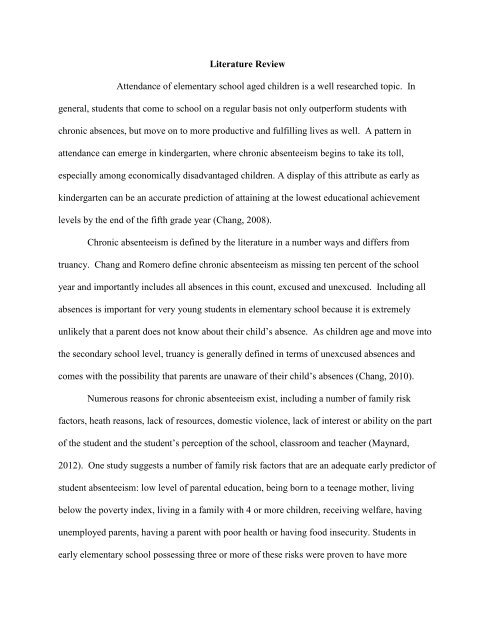Thematic-review-of-the-literature-example
Thematic-review-of-the-literature-example
Thematic-review-of-the-literature-example
- No tags were found...
Create successful ePaper yourself
Turn your PDF publications into a flip-book with our unique Google optimized e-Paper software.
Literature ReviewAttendance <strong>of</strong> elementary school aged children is a well researched topic. Ingeneral, students that come to school on a regular basis not only outperform students withchronic absences, but move on to more productive and fulfilling lives as well. A pattern inattendance can emerge in kindergarten, where chronic absenteeism begins to take its toll,especially among economically disadvantaged children. A display <strong>of</strong> this attribute as early askindergarten can be an accurate prediction <strong>of</strong> attaining at <strong>the</strong> lowest educational achievementlevels by <strong>the</strong> end <strong>of</strong> <strong>the</strong> fifth grade year (Chang, 2008).Chronic absenteeism is defined by <strong>the</strong> <strong>literature</strong> in a number ways and differs fromtruancy. Chang and Romero define chronic absenteeism as missing ten percent <strong>of</strong> <strong>the</strong> schoolyear and importantly includes all absences in this count, excused and unexcused. Including allabsences is important for very young students in elementary school because it is extremelyunlikely that a parent does not know about <strong>the</strong>ir child’s absence. As children age and move into<strong>the</strong> secondary school level, truancy is generally defined in terms <strong>of</strong> unexcused absences andcomes with <strong>the</strong> possibility that parents are unaware <strong>of</strong> <strong>the</strong>ir child’s absences (Chang, 2010).Numerous reasons for chronic absenteeism exist, including a number <strong>of</strong> family riskfactors, heath reasons, lack <strong>of</strong> resources, domestic violence, lack <strong>of</strong> interest or ability on <strong>the</strong> part<strong>of</strong> <strong>the</strong> student and <strong>the</strong> student’s perception <strong>of</strong> <strong>the</strong> school, classroom and teacher (Maynard,2012). One study suggests a number <strong>of</strong> family risk factors that are an adequate early predictor <strong>of</strong>student absenteeism: low level <strong>of</strong> parental education, being born to a teenage mo<strong>the</strong>r, livingbelow <strong>the</strong> poverty index, living in a family with 4 or more children, receiving welfare, havingunemployed parents, having a parent with poor health or having food insecurity. Students inearly elementary school possessing three or more <strong>of</strong> <strong>the</strong>se risks were proven to have more
community involvement to reduce chronic absenteeism. School Community Journal,14(2), 39-56.


